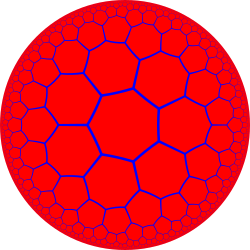Top Qs
Timeline
Chat
Perspective
3-7 kisrhombille
Semiregular tiling of the hyperbolic plane From Wikipedia, the free encyclopedia
Remove ads
In geometry, the 3-7 kisrhombille tiling is a semiregular dual tiling of the hyperbolic plane. It is constructed by congruent right triangles with 4, 6, and 14 triangles meeting at each vertex.
Wikimedia Commons has media related to Uniform dual tiling V 4-6-14.
The image shows a Poincaré disk model projection of the hyperbolic plane.
It is labeled V4.6.14 because each right triangle face has three types of vertices: one with 4 triangles, one with 6 triangles, and one with 14 triangles. It is the dual tessellation of the truncated triheptagonal tiling which has one square and one heptagon and one tetrakaidecagon at each vertex.
Remove ads
Naming
The name 3-7 kisrhombille is given by Conway, seeing it as a 3-7 rhombic tiling, divided by a kis operator, adding a center point to each rhombus, and dividing into four triangles.
Symmetry
There are no mirror removal subgroups of [7,3]. The only small index subgroup is the alternation, [7,3]+, (732).
Related polyhedra and tilings
Summarize
Perspective
Three isohedral (regular or quasiregular) tilings can be constructed from this tiling by combining triangles:
It is topologically related to a polyhedra sequence; see discussion. This group is special for having all even number of edges per vertex and form bisecting planes through the polyhedra and infinite lines in the plane, and are the reflection domains for the (2,3,n) triangle groups – for the heptagonal tiling, the important (2,3,7) triangle group.
See also the uniform tilings of the hyperbolic plane with (2,3,7) symmetry.
The kisrhombille tilings can be seen as from the sequence of rhombille tilings, starting with the cube, with faces divided or kissed at the corners by a face central point.

Just as the (2,3,7) triangle group is a quotient of the modular group (2,3,∞), the associated tiling is the quotient of the modular tiling, as depicted in the video at right.
Remove ads
References
See also
Wikiwand - on
Seamless Wikipedia browsing. On steroids.
Remove ads

















































